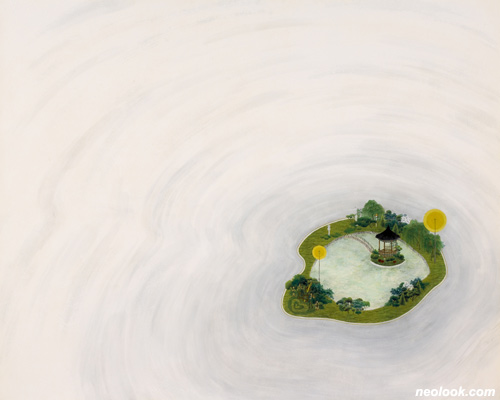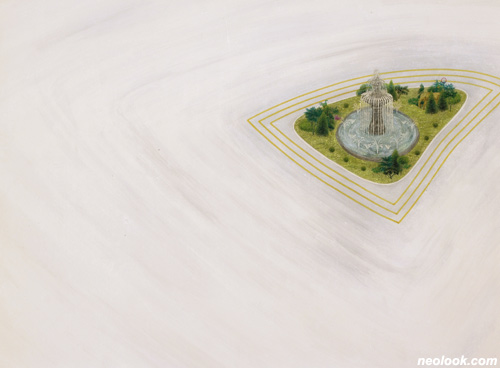- ● homepage
- ● archives
- ● restoration
- ● books
- ● big banners
- ● post board
- ■ neo's search
- ■ about us
- ■ 게재방법 안내
- 개인정보처리방침

- [email protected]
- Tel. 02_335_7922
- Fax. 02_335_7929
- 10:00am~04:30pm
- 월요일~금요일
- 3/3(월) 대체공휴일

도시의 섬 Isle in a city 都市之島
정수진展 / JEONGSUJIN / 鄭隋珍 / painting 2009_0918 ▶ 2009_0930
● 위 이미지를 클릭하면 네오룩 아카이브 Vol.20080416e | 정수진展으로 갑니다.
초대일시_2009_0918_금요일_06:00pm
2009 문화일보갤러리 기획공모 당선전
관람시간 / 11:00am~07:00pm
문화일보 갤러리 MUNHWAILBO GALLERY 서울 중구 충정로 1가 68번지 Tel. +82.2.3701.5755 gallery.munhwa.co.kr
도시 속에서 발견한 외부적 사유의 공간 ● 도시는 자연스레 형성되는 것이 아니라, 인공적으로 주조된 어떤 것이다. 발전이라는 미명하에 낡은 것들이 파괴되고, 새로운 것들이 형성되는 공간이다. 도시는 파괴와 생성의 과정 속에 존재한다. 어떤 것들은 생성을 위해 파괴되기도 하지만, 어떤 것들은 그냥 파괴되기만 할 뿐이다. 사람들이 살아가며 시간 속에 축적시킨 삶의 흔적들은 종종 도시가 가진 변화의 속도 속에 함몰된다. 도시는 끊임없이 변화한다. 문제는 바로 그 변화의 속도이다. 휘황찬란한 변화의 속도는 인간의 의지가 개입할 여지를 남기지 않는다. 어느 순간부터 사람들은 그저 도시의 속도에 적응해 나갈 뿐, 자신만의 속도를 찾을 수 없게 되어 버렸다. ● 정수진의 작업은 바로 이 지점에서 시작한다. 그녀가 주목하는 지점은 자동차가 질주하는 도로의 한 복판에 있는 '안전지대'이다. 자동차가 침범하지 못하는 공간, 자동차를 피해 사람들이 잠시 머무르는 공간. 그 곳은 움직임의 속도가 멈추는 공간이며, 그렇기에 도시의 속도에 함몰되지 않는 공간이다. 때문에 그 곳은 속도의 외부에 놓인 성찰의 공간처럼 보인다. 그녀는 2008년 첫 개인전부터 「도시의 섬」이라는 일련의 작품들을 통해 일관되게 도시 속도의 외부, 그곳의 성찰 가능성을 탐색하고 있다.

- 정수진_도시의 섬_장지에 채색_129×160.6cm_2009

- 정수진_도시의 섬_장지에 채색_117×142cm_2009
그녀는 2009년 또 다시 「도시의 섬」을 주제로 개인전을 마련했다. 그렇다면 그것은 같은 것들의 작은 변주만이 존재하는 지난 전시의 반복일 뿐일까? 그렇지 않다. 그녀의 작품들은 진화하고 있다. 그녀는 이렇게 묻고 있다. 안전지대, 그 곳은 진정으로 멈춤의 공간이며, 성찰의 공간인가? 여전히 그곳은 도시의 속도를 관조하는 곳이라는 점에서 멈춤과 성찰의 공간이지만, 다른 한편으로는 어떤 속도에도 저항할 수 없는 무의미의 공간이기도하다. 그리고 어떤 측면에서 그곳은 도시의 속도를 만들어내는 생산지로서 기능한다. 이 정지된 공간은 도시의 속도를 필연적인 것으로 제시하는 환영들을 만들어낸다. ● 이 환영들은 나무에 장식된 현란한 조명들을 통해, 다양한 모양을 연출해내는 토피어리를 통해 재현된다. 이 토피어리들은 때로는 화목한 가정을, 때로는 해피엔딩을 예고하는 동화의 한 장면을, 때로는 도시 진보를 형상화한 상징들로 전시된다. 도시에서 사는 이들의 속도는 자신의 속도라기보다는 가정을 위해, 아직 오지 않은(未-來) 그래서 현재를 살아가는 우리에게는 앞으로도 오지 않을 해피엔딩을 위해, 자신이 몸담고 있는 가족, 민족, 회사 등 허구적 공동체의 앞날을 위해 적응하고 버텨야할 삶의 속도이다.

- 정수진_도시의 섬_장지에 채색_60×80cm_2009

- 정수진_도시의 섬_장지에 채색_75×103cm_2009
어떤 사물도 다른 사물과 같은 시간을 공유하지 않는다. 도시가 파괴하고 있는 것은 바로 이 개별자들이 독특하게 지니고 있는 시간의 질적 차이이다. 도시의 속도는 개별적 시간을 하나의 균일한 시간으로 흡수해버린다. 정수진의 작품에는 개별자들의 잃어버린 시간에 대한 아쉬움이 묻어 있다. 그녀는 도시의 속도가 물결치는 도로 한 복판에서 새로운 가능성을 찾으려 한다. 속도가 멈추는 곳에서, 즉 추상화된 속도의 텅 빈 결들 속에서 덩그러니 남겨져 있는 안전지대에서 그녀가 찾으려고 하는 것은 새로운 시간을 구성할 수 있는 사유의 공간이다. 그러나 그 곳에는 이미 도시의 속도를 긍정케 하는 신화적 형상들로 가득 차 있다. 정수진은 화려한 조명과 토피어리를 통해 그 신화적 형상들을 비판한다. ● 흥미로운 것은 그녀의 비판 대상이 안전지대 자체가 아니라 안전지대를 채우고 있는 신화적 형상들이라는 것이다. 그녀는 도시의 신화를 비판하면서도, 안전지대를 여전히 도시의 공적 공간 내부에 존재하는 외부로 간주한다. 그래서 그녀는 여전히 추상적 속도가 휩쓸고 다니는 그 도로의 한쪽 편에 있는 안전지대에 조그마한 호수와 정자를 그려 넣음으로써 삶의 여유를 찾고 싶어 한다. 그리고 그 곳에는 어김없이 시속 60Km 이상을 금지하는 도로표지판이 놓여 있다. 그녀는 사람들에게 천천히 혹은 자신의 속도대로 살아가라고 이야기 한다. 그것은 한편으로 사람들에게 자신의 삶을 돌아보라고 이야기 하는 것이기도 하지만, 다른 한편으로는 자기 자신에 대한 속삭임이기도 하다. 도시의 속도 속에서 살아오며 자신이 느꼈던 상실, 결여, 혼돈의 감정들에 대해 이야기 하고 있는 것이다. 정수진은 젠체하는 조언자가 되기보다는 자기 삶의 고민들을 이야기하고 공유하는 작가가 되고자 한다. 그녀의 작품들이 다른 치기어린 작가들의 작품과 달리 허황되거나 과장되지 않고, 진정성 있게 다가오는 것은 바로 그 때문일 것이다. ■ 민호

- 정수진_도시의 섬_장지에 채색_60×85cm_2009

- 정수진_달콤한 인사_장지에 채색_116×90cm_2009
A space of external thought discovered in a city ● A city is not something natural but artificial. It is a space molding new things destroying old things on the pretense of development. A city goes through the process of destruction and creation; something is destroyed for creation, but other thing is just destroyed for nothing. The traces of singular life accumulated in time are often collapsed in a urban speed of change. A city is constantly changing. Yes, that's the speed of change. The splendid speed of change leaves no traces behind for human will to mediate. The other day we only adjusted to the urban speed, could not find their own speed. ● Su Jin Jeong starts at this point. A safety zone in the very middle of the road in which an automobile runs at full speed, of which Jeong takes notice: a space for an automobile not to trespass, which is a shelter for us to avoid it. It is a space that speed of movement stops, and a space not to be ruined by urban speed. It looks life a space of reflection located in the exterior of speed. She has been seeking for the exterior of urban speed all the way through the works in her first private exhibition Isle in a City. ● Jeong arranges her second private exhibition topicalizing Isle in a City again in 2009. The upcoming exhibition is not a repetition of the past one. Her works are now evolving. She asks, "A safety zone, is it really a space of stoppage, and a reflection?" It is still a space of stoppage and reflection in respect that it contemplates urban speed, and also a space of nonsense to resist an every speed. It functions as a producing center to make urban speed in some ways. The static space creates the phantoms which present urban speed something necessary. ● The phantoms are represented by the topiary to produce various shapes through the flowery lightning decorated in trees. The topiaries configurate a harmonious family, a scene of fairy tales previewing a happy ending, and a symbol to find a shape of urban advancement, as the case may be. The speed for an urbanite is a speed of life to endure for a home, a happy ending not yet to come for living-present people, and a fictional community such as a family, nation, and company. ● No thing shares the same time with other things. What a city destroys is the qualitative difference for a singular individual to keep. Urban speed absorbs each singular time into a flat one. We see a yearning for the lost time of an individual in the works of Jeong. She tries to find a new potential in the very middle of the urban road. Where speed stops, that is, a safety zone left by itself in an emptiness of abstract speed, she tries to trace a space of thought to compose a new time. However, there are full of the mythical figures to affirm urban speed yet. Jeong criticizes the mythical figures through flowery lightening and topiaries. Interestingly, she does not criticize a safety zone itself, but the mythical figures filled in it. While criticizing the urban myth, she considers a safety zone still as the exterior existing in public space of a city. That is why she describes, to keep composure, a lake and summer house into a safety zone located in one side of the road that abstract speed is sweeping away. We can surely see a roadside sign forbidding more than 60 kilometers per hour in a safety zone. She advises us to keep on our own living. It means that she tells us to ruminate on their lives, but then it is a whisper to herself. She confesses her own feelings of loss, lack, and chaos in her urban speed. Su Jin Jeong hopes to become an artist to tell and share her worries rather than an conceited advisor. That is the reason we feel true heart from her works, not like those from other puerile artists. ■ Min Ho Huh
Vol.20090918b | 정수진展 / JEONGSUJIN / 鄭隋珍 / painting

